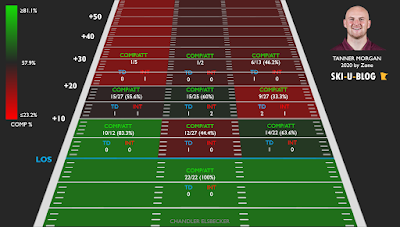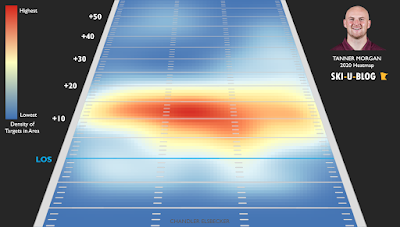After a truncated 2020, Minnesota returns to a full 12-game football season Sept. 2 against Ohio State. Here at Ski-U-Blog will be previews of the team's notable players within each position group. Our next stop in the series is the quarterback position.
Likely Starter
It was a disappointing 2020 for Tanner Morgan. His completion percentage dropped 8 points, and when he completed his passes, he averaged 3.5 fewer yards than the year before. He threw just two more touchdowns than interceptions. Despite being a third-year starter, his statistics were worse than those he posted as a freshman. He went from being getting hyped as a 2021 NFL Draft dark horse (which, to be clear, was never fair) to having his confidence called into question (which also wasn't really fair). What was the deal?
Probably some of it can be attributed to the arrival of new offensive co-coordinator and quarterbacks coach Mike Sanford Jr. — not to say that it is Sanford's fault; the Minnesota offense was very similar to what it was with Kirk Ciarrocca as playcalller, and many of the philosophical problems with Sanford's offense were shared with Ciarrocca's. But any time there is a coaching change, that can have some negative effect as players get acquainted with the new braintrust. That becomes more likely, if not exacerbated, when a pandemic forces teams to spend less time together.
There's also the departure of Tyler Johnson. I will get into the receivers in an upcoming post, but for now we should acknowledge that while Rashod Bateman was Minnesota's most dangerous wideout, Johnson was the most utilitarian. After losing a receiver who could make plays at any level of the field, the Gophers in 2020 relied too much on Bateman to play different roles. Becoming the focus of the offense also meant becoming the focus of the opposing defense.
Bateman's late-season departure also hurt; Minnesota receivers dropped seven passes over the last two games of the season, which docked Morgan a few percentage points on his season-long completion rate.
But Morgan was also just worse. He had some of the worst games of his Gopher career, which could include staggeringly bad passes in front of, over, or short of his receivers.
That wasn't the kind of passer Gopher fans had come to expect. Despite his physical limitations, he had established a fairly consistent level of competent play. Morgan didn't become an altogether bad quarterback in 2020, but that consistency was fleeting.
From a statistical perspective, what did Morgan's step back look like, and what can his coaches do to help reverse it?
 |
| Click on any image in this post to enlarge it. |
Above is a scatter plot of every throw Morgan attempted last season. (I did a different version of this post a year ago analyzing his 2019 season; the rules about data collection and presentation in that post apply here, too.) We'll break down the specifics later, but just by eyeballing the points above, you can pick up on some things.
First: The deep ball nearly disappeared. Two years ago, Morgan threw passes at least 20 yards downfield 17.3 percent of the time. Last year, that number dropped to 10.9 percent.
Taking its place: tap passes, screens, and a greater emphasis on the short game. In 2019, 44.7 percent of his attempts were within 9 yards of the line of scrimmage or behind it. In 2020, those throws made up 61.2 percent of his attempts. It's hard to do damage by relying so much on yards after the catch, and defenses with no reason to be concerned with deep passes will make it harder to pick up yards closer to the line.
Morgan's regression becomes more apparent when looking at his throws divided into buckets. At all three levels of the field beyond the line of scrimmage, his completion rate is substantially lower than it was in the prior season. That includes dipping below 50 percent on both intermediate (10-19 yards) and deep throws after completing around 60 percent of passes at each level last season. The decline of the deep passing game — one of the nation's best — was not only a matter of decreased emphasis but lower performance.
Further bucketing shows more specifically where Morgan was the most and least effective.
(As mentioned last year, Morgan's completion rate in the short middle zone is deflated a bit by deflections at the line. I may adjust how I record these passes in future seasons.)
There was a lot more green on this chart a year ago. The most precipitous fall in Morgan's completion rate was in the intermediate right zone, where he was half as efficient as in 2019.
By completion percentage, Morgan's best spot 10 yards or more downfield is the intermediate middle. He was good there in 2019 as well; his 68.6 percent mark that year was his best in any intermediate or deep zone with a significant number of attempts. This should be no surprise, considering how often and effectively the Gophers throw slants off of RPOs and play-action.
One reason the Minnesota passing game might have been a little worse in 2020 was how much less it attacked this part of the field. Compare these two density plots, showing where Morgan attempted the most passes in 2019 and then in 2020:
Morgan's intermediate throws in 2020 were far more evenly distributed from sideline to sideline, with a greater share of those on the right going to the boundary than in the prior year. In 2019, the intermediate middle tied for Morgan's most-targeted zone and made up 44 percent of his second-level attempts. In 2020, it was the fourth-most-targeted overall and accounted for just under a third of his passes between 10 and 19 yards.
What this might tell us is that Sanford and co-coordinator Matt Simon would do well to attack the middle more often in the passing game, considering it is where their quarterback has had the more success. Without Johnson, they might not have considered the 2020 Gophers as well-equipped to do so. That thought would not have been totally unreasonable: Johnson had more than half of the team's targets in the intermediate middle in 2019.
But Bateman and Chris Autman-Bell demonstrated they could go over the middle while Johnson was still around. Bateman, of course, did a number of things for the Gophers. And Autman-Bell, while he didn't have many intermediate middle targets in 2019, still can hurt opponents running the slant. Take this example from the Gophers' second game of 2020:
I've already covered the receivers and their roles in their own position preview, but the point for now is this: When Minnesota had one of the country's best offenses, attacking the middle was a hallmark of its approach. Though that offense was still good when that tactic became de-emphasized, returning it to prominence in 2021 should help the quarterback. Though Morgan can occasionally hit difficult throws and not long ago helmed one of the most effective deep passing games in college football, he can get into trouble throwing to the sidelines, thanks to his merely okay arm.
If a philosophical shift comes, Morgan will be in a better position to succeed in 2021. Even with one, for Minnesota's passing game to approach the heights it reached two years ago, Morgan will need to clean up his play and return to that reliable form.
Key Backup
Once the starting quarterback, Zack Annexstad has not thrown a regular-season pass since the leaving the 2018 Nebraska game with an injury. The next fall, he suffered a season-ending foot injury during the preseason but still served as captain for every coin toss.
Annexstad's true freshman season was up-and-down, full of mistakes common to true freshmen but not devoid of promise. The public's first glimpse at what he's become since then was the spring game, where his performance could best be described as just fine. His 15-for-24, 243-yard performance was better statistically than Morgan's (aside from two Annexstad interceptions) but lacked many big plays and contained more mistakes.
Because of our limited sample, it's difficult to tell what level of play the Gophers might get from Annexstad if he must see the field this season. It seems reasonable to guess that he is one of the safer backup options in the Big Ten, with his game experience — however removed from it he may be — and three years in the program. It would be unwise to bet that the Gophers' offense with Annexstad would have the same ceiling as it does with Morgan, however.
If Morgan doesn't return for a "super senior" season in 2022, Annexstad might be the frontrunner in an ensuing quarterback competition.
Package Player
After a greyshirt year, true freshman Dylan Hilliard-McGill appears to be the new Wildcat quarterback. At Mesquite High School (Texas), Hilliard-McGill ran for nearly as many yards (936) as he threw for (1199) as a senior. He was considered an athlete as a recruit and will move to receiver. At 6 feet, 3 inches and 210 pounds, he has size befitting Seth Green's successor, but his highlights show off some breakaway speed. Hilliard-McGill did not play in the spring game, so we don't know how that pace plays against Division I competition. Still, it's possible he has enough quickness to offer a slight departure from Green's profile as primarily a battering ram.
Notables Unlikely to Contribute
Four-star true freshman Athan Kaliakmanis is the program's 19th-highest-rated recruit in 247Sports' records but will surely be redshirted in 2021 and is a decent bet to start in 2023. Jacob Clark and Cole Kramer alternated backup duties in Annexstad's absence in 2019; neither played a snap last season, and the only statistic either recorded in the spring game was Kramer's one time being sacked. All three could be in the mix for the 2022 starting job but will face an uphill battle against Annexstad's seniority.








No comments:
Post a Comment
Note: Only a member of this blog may post a comment.